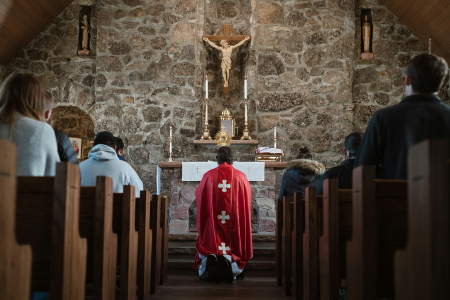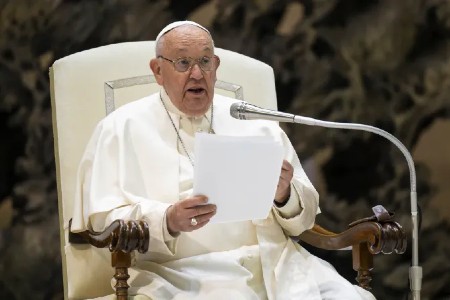 Hi readers, it seems you use Catholic Online a lot; that's great! It's a little awkward to ask, but we need your help. If you have already donated, we sincerely thank you. We're not salespeople, but we depend on donations averaging $14.76 and fewer than 1% of readers give. If you donate just $5.00, the price of your coffee, Catholic Online School could keep thriving. Thank you. Help Now >
Hi readers, it seems you use Catholic Online a lot; that's great! It's a little awkward to ask, but we need your help. If you have already donated, we sincerely thank you. We're not salespeople, but we depend on donations averaging $14.76 and fewer than 1% of readers give. If you donate just $5.00, the price of your coffee, Catholic Online School could keep thriving. Thank you. Help Now >
Genoa
FREE Catholic Classes
ARCHDIOCESE OF GENOA (JANUENSIS)
Archdiocese in Liguria, Northern Italy. The city is situated on the gulf of the same name, extends along the lowest ridges of the Ligurian Apennines, which sweep around the gulf, between the mouths of the Polcevera and the Bisagno, and is protected from the inroads of these waters by the Punta della Lanterna and the Punta del Carignano. The bay forms a natural harbour secured against storms by the promontory of Portofino, which acts as a breakwater. Two piers (the smaller one begun in 1133) were necessary to break the force of the tide during storms. Its favourable position has made Genoa the largest trade centre on the Mediterranean. It is also a naval fortress with a chain of defences about ten miles in length.
In 205 B.C., Mago the Carthaginian landed there with a large army, and sacked the town for its sympathy with Rome, the rest of Liguria supporting the Carthaginians. From the end of the Second Punic War, Genoa belonged to Rome. After the Lombard invasion, it remained subject to Byzantium, like nearly all the maritime towns of Italy. In A.D. 641 King Rotari, in his expedition along the coast of Liguria, sacked Genoa, and carried off immense booty. It was later incorporated in the Lombard kingdom, probably under Charlemagne, becoming part of the March of Obertenga. In 935, it was surprised and sacked by the Saracens, but the Genoese fleet followed up the enemy and defeated them near the island of Asinara. In 1008, the Saracens came for the third time. Meanwhile the trade and enterprise of Genoa had steadily increased, and now rivalled that of Pisa, in those early times its friendly neighbour. In 1016, they drove the Arab chief Mogalied from Sardinia. In 1052, the town organized itself into a commune, and was governed by consuls and a podestà (mayor); in 1258, however, the control was divided between the podestà and a "captain of the people", a condition which lasted till 1310. From 1339 to 1797, except when the rule was in the hands of foreigners, the city was governed by doges chosen from the principal families, at first for life, but after 1528 for periods of two years.
In 1087, the Genoese and Pisans captured Almadia and Subeila in Africa. In the First Crusade their fleet transported the crusading armies to the Holy Land, secured many ports in Syria and Palestine for the Christians, and, in return for their services, they were granted important commercial privileges among the Christian principalities of the East . Together with the Pisans they aided Innocent II to put down the schism of Anacletus, and, as a reward, the pope divided between the two municipalities the islands of Sardinia and Corsica, retaining, however, his own overlordship. In 1147, they took Almeria and Tortosa, in Spain, from the Moors. The threatening attitude of Genoa forced Frederick Barbarossa to recognize all its liberties and possessions; hence, until the reign of Frederick II, it remained friendly to the imperial cause, and even assisted in the attack on Sicily. In 1240, however, the Genoese refused to do homage to Frederick II, and, in 1241, they lent their fleet to transport the northern prelates to the council convened by Gregory IX, but were pursued and defeated between the islands of Il Giglio and Monte Cristo by the Pisans, the allies of the emperor. In 1244, Innocent IV took refuge in Genoa. The commercial favour shown by the Latin Empire of Constantinople (1204-60) towards the Venetians enabled the latter to defeat the Genoese at St-Jean d'Acre and on the high seas, in 1257 and 1258 respectively. In 1261, the Genoese took their revenge by assisting Michael Palæologus to reconquer Constantinople, and obtained from him Smyrna and Pera, and the monopoly of trade in the Black Sea. They developed markets rapidly on the shores of this sea, the principal one being Caffa, and carried on a brisk trade, exporting mainly wine, oil, woollens, and silks, and importing skins, furs, corn, Persian stuffs, etc. For the government of these colonies, a general consulate of the empire of Gazaria was established.
A bitter war now began between the rival cities of Genoa and Pisa. From 1262 to 1267, five naval battles (Settepozzi, Durazzo, Trapani, Tyre, and St-Jean d'Acre) were fought, in which Genoa was generally the loser. St. Louis IX of France sought to establish peace on a firm footing (Cremona, 1270); but a revolt in Corsica, stirred up by the Pisans, soon led to another war (1282-1284), which ended in the utter defeat of the Pisans near the island of Meloria. Soon the old rivalry with Venice was renewed, and the scene of the conflict shifted to the East. At Laiazzo, on the coast of Armenia, the Genoese were victorious (1294); the Venetians retaliated by destroying the Genoese quarter of Galato (1296), but in 1298 Lamba Doria (founder of the Doria family, famous in the annals of Genoa) totally destroyed the Venetian fleet at Curzola. Both rivals being now weakened, Henry VII (1311) easily obtained from the Genoese the right to govern them for twenty years, and a promise of help against Naples. A little later, Robert of Anjou (1318-1335) was called in by the Guelphs in opposition to the Visconti of Milan, favoured by the Ghibellines. When the Venetians, together with the Greeks and the Catalonians, wished, in 1342, to occupy the island of Scio as an outpost against the Turks, the Genoese, profiting by a quarrel among the allies, forestalled them. This, amongst other causes, led to a fresh outbreak of war in 1350. In the Bosphorus (1352), a fierce but indecisive battle was fought; while at Alghero in Sardinia (1353) the Genoese were defeated by the Venetians and their allies. Genoa then chose Giovanni Visconti, Archbishop of Milan, as its ruler of "Signore". In 1354, Paganino Doria routed the Venetian forces in the Adriatic and at Porto Longone in the Morea (Greece). Driven out of the Black Sea, the Venetians took Beirut by way of compensation, and Genoa seized Cyprus (1373). When the Greek Emperor, John V, gave the Venetians the island of Tenedos, the Genoese, fearing lest the former should thereby have access to the Black Sea, espoused the cause of Andronicus; in this way broke out the conflict known as the War of Chioggia. The Genoese, defeated at Anzio (1378), were victorious at Pola (1379) and blockaded Venice, but were obliged to surrender when the blockade was broken by Vettor Pisani. The great rivals were now exhausted.
During the fifteenth century, Genoa constantly called on outsiders to rule her, but as constantly rebelled against their rule (1396-1409, France ; 1409-1413, Teodoro II Paleologo di Monferrato; 1422-1435, Filippo Maria Visconti; 1458-1461, France ; 1464-1478, 1487-1499, the Sforza of Milan ; 1499-1512, 1515-1522, France ). Meanwhile her colonies in the East were slipping away (Pera, 1453; Caffa, 1475). In 1431, at Portofino, the fleet in the service of Visconti was defeated by the Venetian and Florentine allies. Genoa was involved in the conflict between Francis I and Charles V, and in 1522 was sacked by the Spaniards. In 1527, the Spanish were expelled by the celebrated Andrea Doria with French aid, and in the year following Andrea succeeded in ridding himself of his French allies. The "Signoria" was offered him, but he prudently refused the title, though in reality he exercised its powers. This brought about the Fieschi Plot (1546), which proved abortive owing to the death of its leader. Noteworthy events in the subsequent history of Genoa are the attempts of Corsica to shake off Genoese authority (1553; 1737, King Theodore), its annexation by France in 1768, and the two conspiracies for the annexation of Genoa by Savoy (Vachero, 1628; Della Torre, 1672). In 1684, Louis XIV, without any just cause, had the town bombarded. A hundred years later (1797) the French set up there a democratic republic. In 1800, Massé na sustained a famous siege and blockade on the part of the Austrians and English. In 1805, the duchy was annexed to France, but in 1814 was provisionally, and in 1815 definitely, annexed to the Kingdom of Sardinia.
Genoa owes to the magnificence of its architecture its title of "La Superba" (the Proud ). Among its best-known churches are: San Lorenzo, rebuilt in the twelfth century, the lower part of the façade dating from 1100, the remainder from 1523. The spandrils over the door are decorated with bas-reliefs of various periods. The cupola dates from 1567. There are paintings by Barrocci, Ferrari, Cambiaso, and sculptures by Montorsoli, Sansovino, Guglielmo della Porta and others. Near by is the little church of St. John the Baptist, formerly the baptistery of the city. The church of Saints Andrew and Ambrose (600) has paintings by Guido Reni and Rubens. Santissima Annunziata has beautiful Composite columns, and a famous Last Supper by Procaccino. In the church of St. Catherine of Genoa (with the saint's room adjoining) may be seen her body preserved in a silver urn. The church of Saints Cosmas and Damian antedates the year 1000; that of St. Donatus, consecrated in 1189, is built of old Roman materials. St. Philip Neri dates from 1694; the Gesù Maria from 1487. The latter has paintings by Paggi, Cambiaso, and Salimbeni. St. George's has two bronze doors, a part of the booty of Almeria (1148). The altar of St. John's was erected after the victory at Pola. On the façade of St. Mark's (1173) is a marble lion captured from the Venetians at Pola. Other churches are: Santa Maria in Castello (columns of oriental granite); Santa Maria del Carmine (rich tabernacle); San Siro (the cathedral till 985); San Stefano, which existed in 493, and has a painting by Giulio Romano. San Matteo, containing the war-trophies of the Dorias, was founded in 1125 by Martino Doria, and restored by Andrea Doria from plans by Fra Giovanni Angelo Mortorsoli; on the façade is the sarcophagus of Lamba Doria, the victor at Curzola; under the high altar is the tomb of Andrea Doria by Montorsoli, and several inscriptions recall the triumphs of this noble family of seamen and rulers. Santa Maria in Carignano (sixteenth century), one of the handsomest churches in the world, is in the form of a Greek cross; its cupola is the work of Galeazzo Alessi of Perugia. The Campo Santo, or public cemetery, is also greatly admired for its beautiful statuary. Among Genoa's public edifices are the Albergo dei Poveri, or home for the poor (1655), with a church attached; the Loggia dei Banchi, or exchange, built by Galeazzo Alessi. The Palazzo Ducale (1291) is crowned with a row of stucco statues of the various princes and kings defeated by the Genoese; its spacious halls were adorned by famous artists. The Palazzo S. Giorgio (1260), restored in 1368, has many statues of the doges of the fifteenth century. Worthy of notice also are the university, founded in 1471 by Bartolomeo Bianco, the Palazzo Reale, and the Municipio or Town Hall. Genoa has many famous private palaces, e.g. the Adorno, with paintings by Rubens, Guido Reni , Titian, and Giulio Romano ; the Doria, with a representation of St. George and the Dragon over the doorway. Besides the university, there is a merchant-marine school, a Catholic high school, an academy of fine arts and other institutions of a similar nature.
We ask you, humbly: don't scroll away.
Hi readers, it seems you use Catholic Online a lot; that's great! It's a little awkward to ask, but we need your help. If you have already donated, we sincerely thank you. We're not salespeople, but we depend on donations averaging $14.76 and fewer than 1% of readers give. If you donate just $5.00, the price of your coffee, Catholic Online School could keep thriving. Thank you.Help Now >
The line of bishops is usually dated from St. Solomon or Salonius, said to have been martyred in 269. Other bishops are mentioned in the third and fourth centuries, the first known with any certainty being Diogenes, a member of the Council of Aquileia in 381. Blessed Jacobus a Voragine, author of the Legenda Aurea (Golden Legend) and Bishop of Genoa (1292-1298), tells us that till the tenth century he found no mention of a Bishop of Genoa, thus proving that in his time nothing was known of the legendary martyred bishops. The St. Syrus I assigned to the beginning of the fourth century may therefore be a double of St. Syrus II (1139-1163). When the Lombards captured Milan (568), its bishop, Laurentius, and many of his clergy took refuge in Genoa; five other Milanese bishops took up their residence there. It was this same Laurentius who dedicated the church of St. Ambrose built for the Milanese refugees. About 617, Bishop Appellinus became involved in the schism of Agrestius. In 634, Bishop Asterius ordained St. Byrsinus, who was to be one of the apostles of Northumbria.
Councils were held at Genoa in 773 (?), 1216, and 1292. Innocent IV and Adrian V were natives of the city. It was originally a suffragan of Milan, but, in 1133, Innocent II made it a metropolitan see. Its first archbishop was the St. Syrus mentioned above. Its suffragan sees are Albenga, Bobbio, Brugnate and Luni-Saranza, Chiavari, Savona and Noli, Tortona, Ventimiglia. In has 200 parishes and 470,000 souls (161,000 in the city); there are 33 religious houses for men in the city, and 19 throughout the diocese ; also 62 convents for women in the city, and 82 throughout the diocese. The archdiocese supports 2 Catholic daily newspapers, 3 weekly papers, and 13 other periodicals.
We ask you, humbly: don't scroll away.
Hi readers, it seems you use Catholic Online a lot; that's great! It's a little awkward to ask, but we need your help. If you have already donated, we sincerely thank you. We're not salespeople, but we depend on donations averaging $14.76 and fewer than 1% of readers give. If you donate just $5.00, the price of your coffee, Catholic Online School could keep thriving. Thank you.Help Now >
Join the Movement
When you sign up below, you don't just join an email list - you're joining an entire movement for Free world class Catholic education.
-

-
Mysteries of the Rosary
-
St. Faustina Kowalska
-
Litany of the Blessed Virgin Mary
-
Saint of the Day for Wednesday, Oct 4th, 2023
-
Popular Saints
-
St. Francis of Assisi
-
Bible
-
Female / Women Saints
-
7 Morning Prayers you need to get your day started with God
-
Litany of the Blessed Virgin Mary
U.S. Catholic Parishes Experience Resurgence of Traditional Practices
-

Pope Francis Urges Faith and Prayers for Peace
-

Florida Welcomes Volunteer Chaplains to Public Schools
-
10 Fascinating Details About St. Joseph the Worker: Celebrating His Feast Day - May 1
-
St. Joseph the Worker: Model for Men, Young and Old
Daily Catholic
 Daily Readings for Thursday, May 02, 2024
Daily Readings for Thursday, May 02, 2024 St. Athanasius: Saint of the Day for Thursday, May 02, 2024
St. Athanasius: Saint of the Day for Thursday, May 02, 2024 The Our Father: Prayer of the Day for Thursday, May 02, 2024
The Our Father: Prayer of the Day for Thursday, May 02, 2024- Daily Readings for Wednesday, May 01, 2024
- St. Marculf: Saint of the Day for Wednesday, May 01, 2024
- To Saint Peregrine: Prayer of the Day for Wednesday, May 01, 2024
![]()
Copyright 2024 Catholic Online. All materials contained on this site, whether written, audible or visual are the exclusive property of Catholic Online and are protected under U.S. and International copyright laws, © Copyright 2024 Catholic Online. Any unauthorized use, without prior written consent of Catholic Online is strictly forbidden and prohibited.
Catholic Online is a Project of Your Catholic Voice Foundation, a Not-for-Profit Corporation. Your Catholic Voice Foundation has been granted a recognition of tax exemption under Section 501(c)(3) of the Internal Revenue Code. Federal Tax Identification Number: 81-0596847. Your gift is tax-deductible as allowed by law.









 Daily Readings for Thursday, May 02, 2024
Daily Readings for Thursday, May 02, 2024 St. Athanasius: Saint of the Day for Thursday, May 02, 2024
St. Athanasius: Saint of the Day for Thursday, May 02, 2024 The Our Father: Prayer of the Day for Thursday, May 02, 2024
The Our Father: Prayer of the Day for Thursday, May 02, 2024

